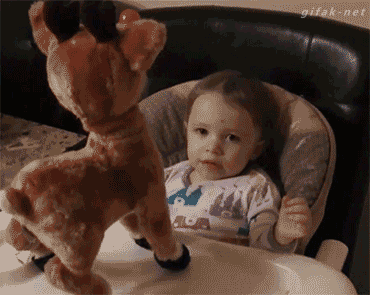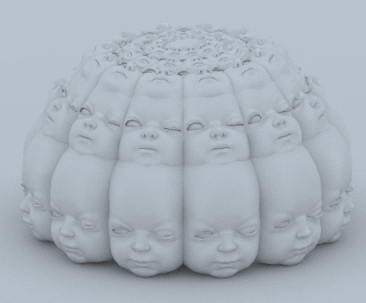Geography 353 Cartography and Visualization
...to Geog 353 Main Page and Course Description
...to Geog 353 Syllabus
...to Geog 353 Course Schedule and Lecture Outlines
...to Geog 353 Laboratory Information and Student Projects
Geog 353 Lab 9: Cartographic Animation
Update: 11/4/19
- 50 points
- ASSIGNED: Monday November 11
- DUE: Wednesday November 20
Lab 9 Goal: In Lab 8 you exported three sets of maps and associated
legends from ArcGIS in .png format. The next step is
to animate your maps and include them in your HTML for the world to behold.
Details:
First, a bit of background on map animation...
- "In the motion picture lies a highly essential but much
neglected field for pictorial statistics. Newsreels, war films and such
features as "The March of Time," McCrary's "Ringside Seat" or "Kaltenborn Edits
the News" occasionally incorporate maps, but usually they are either globes or
maps clipped from newspapers and similar sources. But the screen offers the
best imaginable opportunities for "dynamic" visual information. On the screen
arrows can really move as opposing armies advance or retreat, statistical
columns can grow or shrink, frontiers can be violated and empires can literally
"crumble." The effect created by such "living" maps and graphs can be further
heightened by an effective accompaniment of words or music. One could both see
and hear a "frontier" "break down," the tramping "men" in the statistical column
"join the army," "the whistling ships" slide down the ways and the like. Why not
include such a map feature, dynamically illustrating current war events, in the
newsreels? Why not visualize the growth of line-lease aid, the progress of the
war-bonds campaign, in pictorial statistics that move? Why not portray
Germany's exploitation of the occupied countries by maps on which the
confiscated goods actually march into the Reich? Or depict the effect of air
raids, swarms of planes (in symbols) dropping bombs across a map of strategic
and key industrial points? Why not dramatize the unrest in Nazi-occupied Europe
by flashing on a map those places where hostages have been executed, troop
trains have been derailed, underground papers have been secretly edited and
printed. These few suggestions indicate how great can be the improvement in the
techniques and therefore the effectiveness of visual means for conveying
information about the war. (Heinz Soffner. "War on the Visual Front." The
American Scholar 11:4, 1942. pp. 465-476. Quote from page 476-77)
This multimedia extravaganza envisioned by Soffner in 1942 was suggested
by the need for war-time propaganda. What is interesting is that there is a
clear sense that adding a dynamic component to maps will "enliven" them and make
them more effective.
Animation can be defined as "...a dynamic visual statement that evolves
through movement or change in the display. The most important aspect of
animation is that it depicts something that would not be evident if the frames
were viewed individually. In a sense, what happens between each frame is more
important than what exists on each frame."
Animation works because the eye-brain mechanism retains, for a fleeting
instant, images of objects it has seen after the objects have been removed. If
the eye is shown a series of static views of objects at a rapid rate (30 per
second) with the objects changing positions only slightly from frame to frame,
the illusion of life like motion - animation - is created in the mind.
A Short History of Animation
- suggested in 1824 by Peter Roget: "The persistence of vision with
regard to moving objects" presented to the British Royal Society.
- 1831: Dr. Joseph Antoine Plateau and Dr. Simon Ritter constructed a machine
called a phenakistoscope which produced an illusion of movement by
allowing a viewer to gaze at a rotating disk containing small windows behind
which was another disk containing a sequence of images. When the disks were
rotated at the correct speed, the synchronization of the windows with the images
created an animated effect.
- 1887: Thomas Edison started research work into motion pictures.
- 1896: Thomas Armat designed the vitascope which projected the films
of Thomas Edison; this machine had a major influence on all subsequent
projectors.
- 1906: J. Stuart Blackton made the first animated film called
'Humorous phases of funny faces'.
- 1909: Winsor McCay produced a cartoon called 'Gertie the Trained Dinosaur'
consisting of 10,000 drawings.
- 1913: Pat Sullivan created an American cartoon series called 'Felix the
Cat'
- 1926; Lotte Reiniger produced the first feature-length animated film
called 'Prince Achmed'.
- 1928: Walt Disney created the first cartoon with synchronized sound
called 'Mickey Mouse'.
- 1957: John Whitney used 17 Bodine motors, 8 Selsyns, 9 differential gear
units and 5 ball integrators to create analogue computer graphics.
- 1964: Ken Knowlton, working at Bell Laboratories, started developing
computer techniques for producing animated movies.
- Computer animation software for desktop computers developed in the 1970s,
and the WWW has made animated graphics available to a broad audience of users.
The creation of animations for the WWW is easy, in large part due to the GIF
graphic file format.
1. GIF Animations: Animation for the People or Scourge of the Internet?

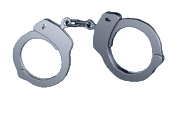
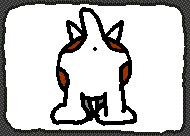


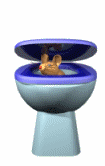
GIF (Graphics Interchange Format) is a common graphic file format, one of the primary graphic file
formats used on the WWW (along with JPG). It was developed by Steve Wilhite for CompuServe,
in an office building in north Columbus. It was first used in 1987. One interesting characteristic of GIF
files is that they can have layers and thus you can put multiple GIF
files into a single GIF file (one file on each layer).
When a GIF file with layers is viewed on the WWW it flips through the layers one by one:
thus you can use GIF files to easily create animated graphics for the WWW. Just like above.
Stare at the animations (above) for a moment, then ponder the annoyance factor
when experimenting with GIF animation for your project.
The hug advantage (huge too!) of GIF animation is that no special browser plug-ins are
needed to view the animations (even the oldest computers with out of date browsers can
show them quickly) and they are easy to create with free or low-cost software.
Sadly, GIF files have really crappy resolution. While that might cast some olde-time charm
upon the medium, it causes problems when we are using GIFs for map animations. Colors
are often different from the originals, and resolution is coarse.
Along comes the PNG file
to the rescue. PNG (Portable Network Graphics) are lossless (they maintain
quality from the original - in our case, ArcGIS) and, over the last few years, more web sites
are appearing which help you generate animations from PNG files. Importantly, most browsers now
support animated PNGs.
Each of you will create at least four PNG animations:
- Graduated Color (Choropleth) map of population change in your state(s), 1900-2018
- Graduated color (Choropleth) map of population change gains and
losses (a 2 class map), 1900-2018. You will have to go back to ArcGIS and create a
new classification (2 classes, split at 0), export, and animate the files.
- Graduated Symbol map of total population in your state(s), 1900-2018
- Dot Density map of total population in your state(s), 1900-2018
Creating Animated PNGs - APNG
Three sites are listed below. There are others. Start with the first, and move on to the others
if you are having problems.
Think a bit about some options that would be nice to have: see if the sites above can provide
these options:
- modify the speed of the animation (include fast medium and slow versions on your web pages)
- ability to loop the animation
- ability to add a title layer or image to your animation
- document additional functions of the GIF animation sites you discover
Once you have saved your APNGs, go back to your HTML files, open and add the animated PNG
file names (just like you would add any image)
You will finish this lab with four animated PNG maps (choropleth - two class and original classification; graduated
symbol map, dot map).
Embed them in your HTML pages, spiff up the pages, and upload to the web.
You will present your web pages with animations the last week of classes.
For your lab log note any prob lems you encountered and define the following:
- Animation
- .GIF Animation
- .PNG Animation (APNG)
Next: Presentation of final project + Final Evaluation (Lab 10).
E-mail: jbkrygier@owu.edu
...to Geog 353 Main Page and Course Description
...to krygier teaching page.
...to krygier top page.
OWU Home
OWU Geology and Geography Home








